India – Kumbh Mela
Die größte spirituelle Ansammlung von Menschen weltweit
The greatest spiritual gathering of people anywhere in the world
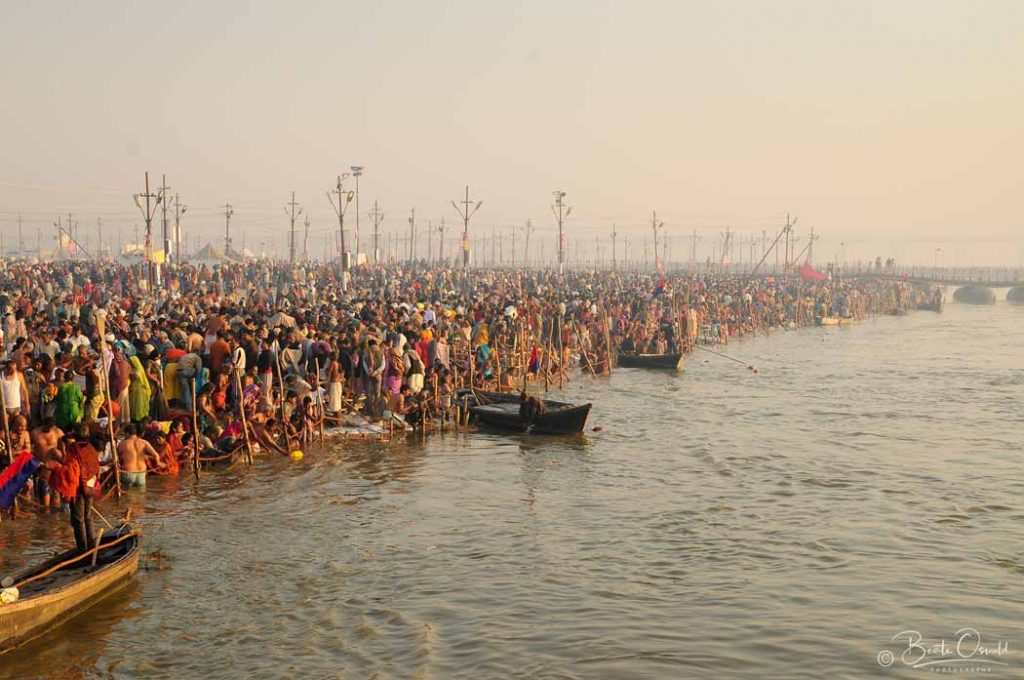
Please scroll down for the English version
Alle zwölf Jahre findet am Zusammenfluss von Ganges, Yamuna und dem mythischen Sarasvati die größte religiöse Versammlung von Menschen auf der ganzen Welt statt. Hindus glauben, dass sie sich durch rituelles Baden während der Kumbh Mela von vergangenem Fehlverhalten reinigen, Heilung und Erleuchtung sowie eine Verkürzung des endlosen Kreislaufs der Wiedergeburt erlangen können. 2013 war die Kumbh Mela besonders vielversprechend für die Pilger, denn die Sterne standen so günstig wie seit 144 Jahren nicht mehr. Schätzungsweise 100 Millionen Pilger aus ganz Indien und darüber hinaus versammelten sich im Verlauf der 55-tägigen Feier. Neben „normalen“ Hindus zieht die Kumbh Mela bis zu einer halben Million Sadhus an (fromme heilige Männer, Anhänger von Vishna, Shiva und anderen hinduistischen Gottheiten, die oft auf weltliche Besitztümer verzichtet haben). Sechs Tage lang besuchte ich die Maha Kumbh Mela, einschließlich der Mauni Amavasya (der Nacht des Neumondes, dem Höhepunkt des Festivals) und ließ mich von den nicht enden wollenden Pilgerströmen von und zu den Badeplätzen treiben, zu den Orten der Sadhus, umgeben von Stimmengewirr, Lautsprecheransagen und indischen Klängen.
English version:
Every twelve years, the greatest religious gathering of people anywhere in the world takes place at the confluence of the Ganges, Yamuna and the mythical Sarasvati. Hindus believe that by bathing here during the Kumbh Mela festival they can purify themselves from any wrongdoing, bring healing and enlightenment and have a positive effect on their next rebirth. The 2013 Kumbh Mela was particularly auspicious, as the stars were in a very special constellation, for the first time in 144 years. An estimated 100 million pilgrims from all over India and beyond gathered over the course of the 55 day celebration. As well as normal worshipers, the Kumbh Mela attracts up to half a million Sadhus (devout holy men, followers of Vishna, Shiva and other Hindu deities who often have renounced worldly possessions). I joined the celebration for six days, including the Mauni Amavasya (the night of the new moon, the climax of the festival) and let myself be carried away by the never-ending stream of pilgrims from and to the bathing places, to the Sadhus, enveloped in hubbub, loudspeaker announcements and Indian sounds.
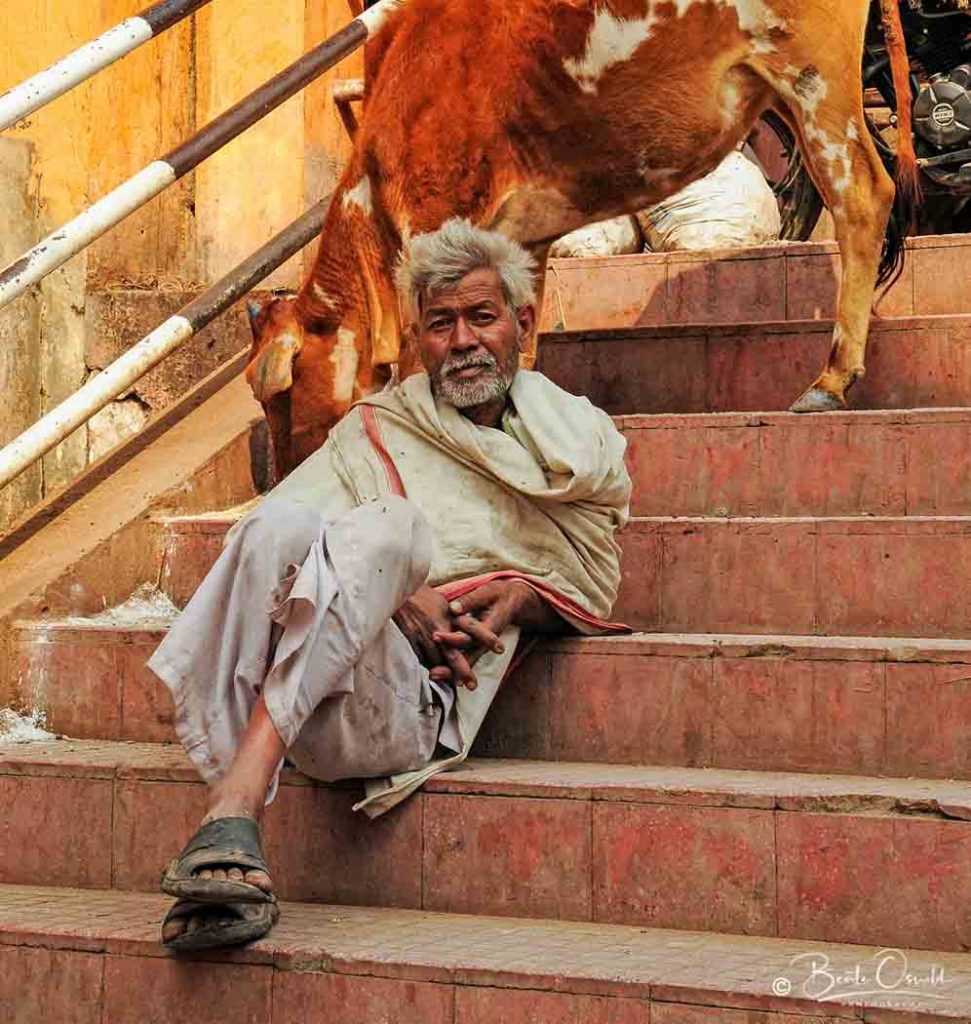
Viele Pilger kamen auf dem Weg zur Kumbh Mela durch das bedeutende Omkareshwar mit seinen heiligen Stätten und Tempeln. Die Anmut, Gelassenheit und Würde dieses Mannes, den ich dort traf, ließen mich auf meiner Reise innehalten. Er war so freundlich, und ließ mich ein Bild von ihm machen.
English version:
Many pilgrims passed through the ancient shrine of Omkareshwar on the way to the Kumbh Mela. The grace, composure and dignity of this man who I met there, stopped me in my tracks. He was kind enough to let me take his picture.
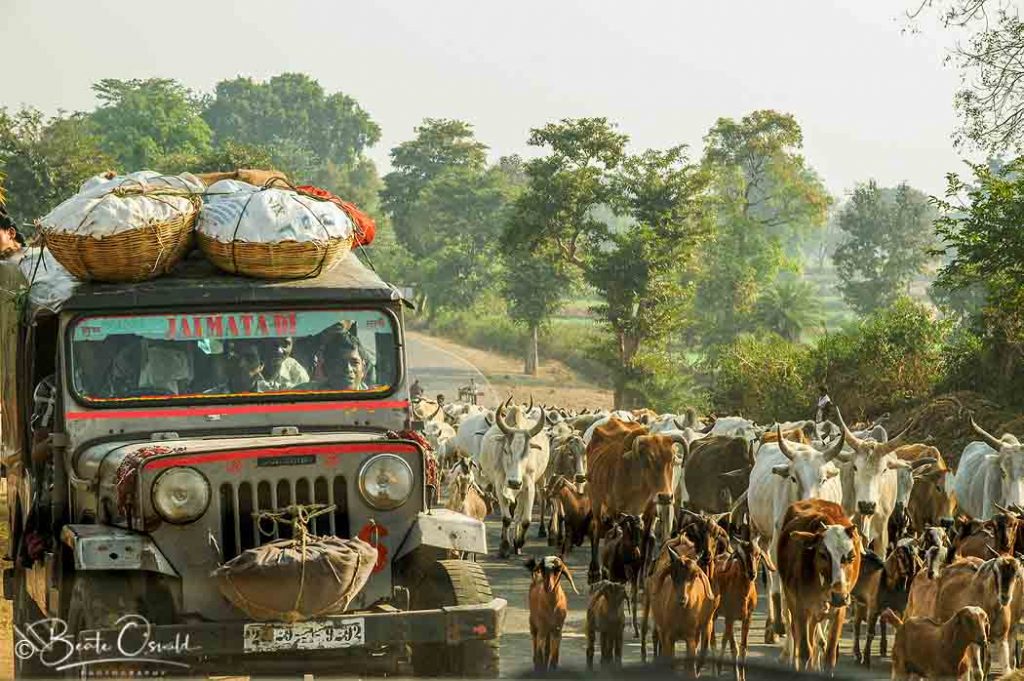
Überlastung auf dem Weg nach Allahabad im Jahr 2013. 2018 erhielt die Stadt ihren historischen Namen „Prayagraj“ zurück.
English version:
Congestion on the road to Allahabad in 2013. In 2018 the city got its historical name “Prayagraj” back.
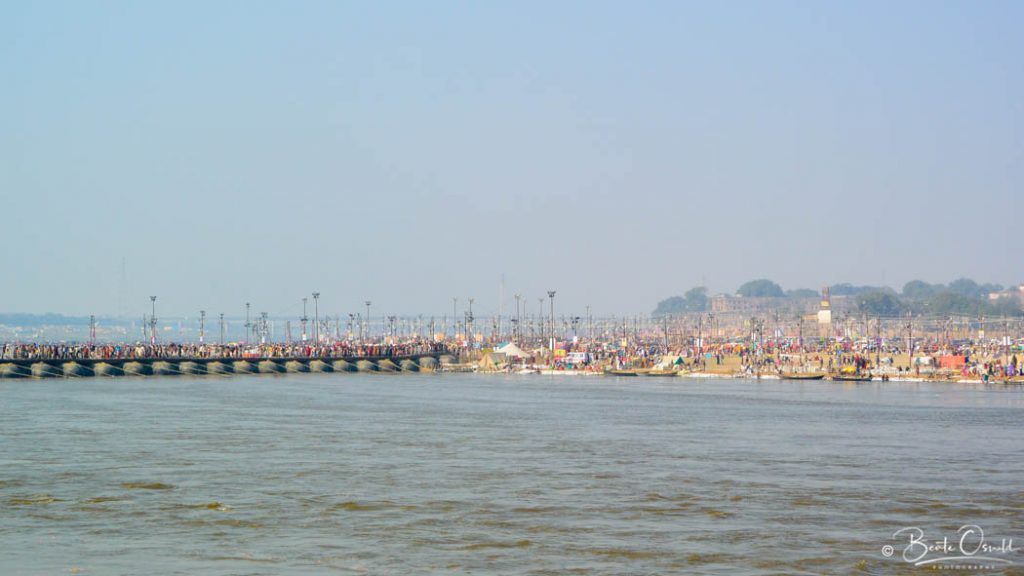
Einige Tage vor dem Mauni Amavasya wird der Pilgerstrom zum Flussufer größer und größer. Um die Pilger aufnehmen zu können, wurde neben Allahabad (seit 2018 Prayagraj) eine etwa 20 Quadratkilometer große temporäre Zeltstadt errichtet. Millionen von Menschen leben in diesen Zelten und gehen jeden Tag zu und von den wichtigsten heiligen Orten. Um die Badebereiche erreichen zu können, müssen sie den Fluss überqueren. Dafür wurden 18 temporäre Pontonbrücken für die Pilger errichtet.
English version:
A few days before the Mauni Amavasya, the stream of pilgrims to the river bank is getting bigger and bigger. To accommodate the pilgrims, an approximately 20 square-kilometer large temporary tent city was set up next to Allahabad (since 2018 Prayagraj). Millions of people live in those tents and walk to and from the main holy places each day. To be able to reach the bathing areas, they need to cross over the river. Therefore 18 temporary pontoon bridges were set-up for the pilgrims.
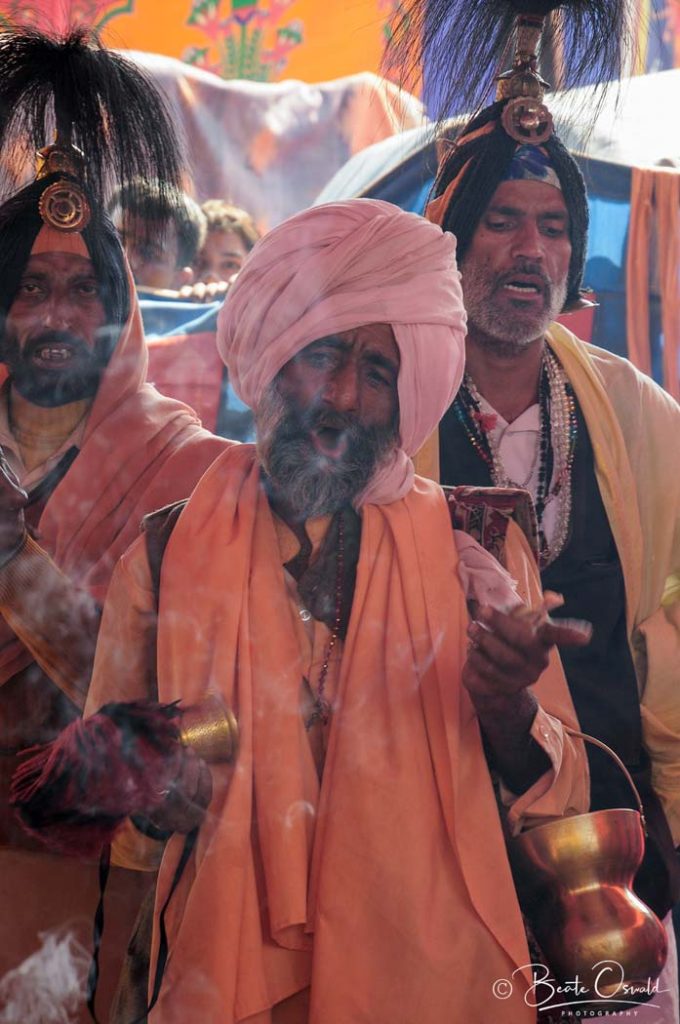
Safranfarbene Gewänder werden im Hinduismus mit der Reinigung von Feuer in Verbindung gebracht.
English version:
Saffron-coloured robes are associated with cleansing fire in Hinduism.
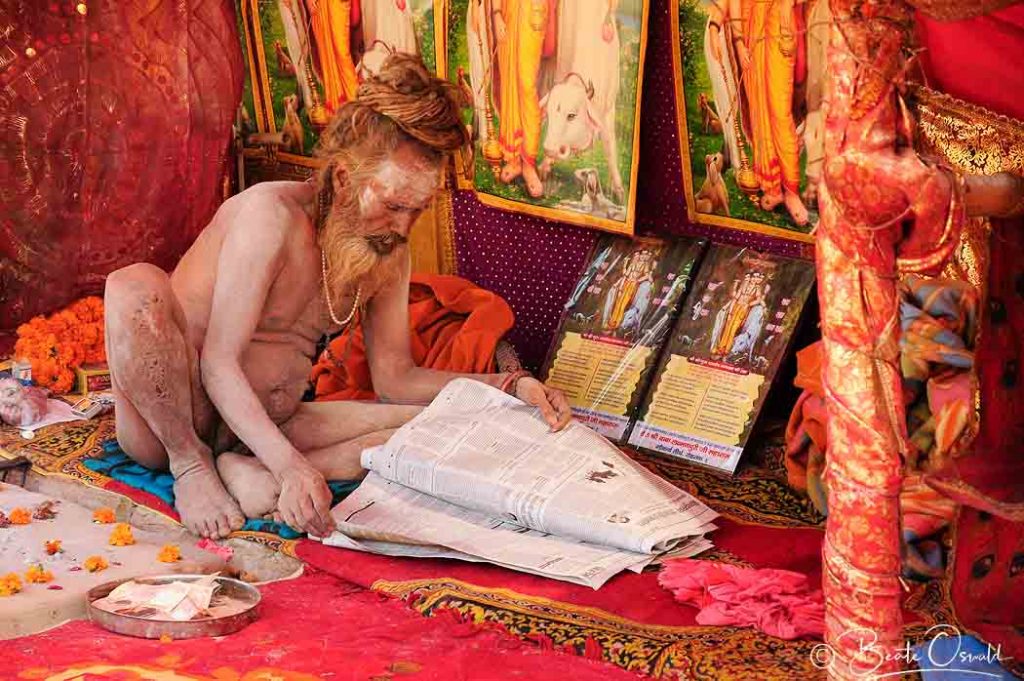
Die Nagas sind Sadhus, die keine Kleidung tragen und ihren Körper mit Asche bedecken. Es kann vorkommen, dass Sadhus wochenlang unterwegs sind, um an der Kumbh Mela teilzunehmen.
English version:
The Nagas are Sadhus who wear no cloths and cover their bodies with ashes. It can happen, that Sadhus will have walked for weeks to attend the Kumbh Mela.
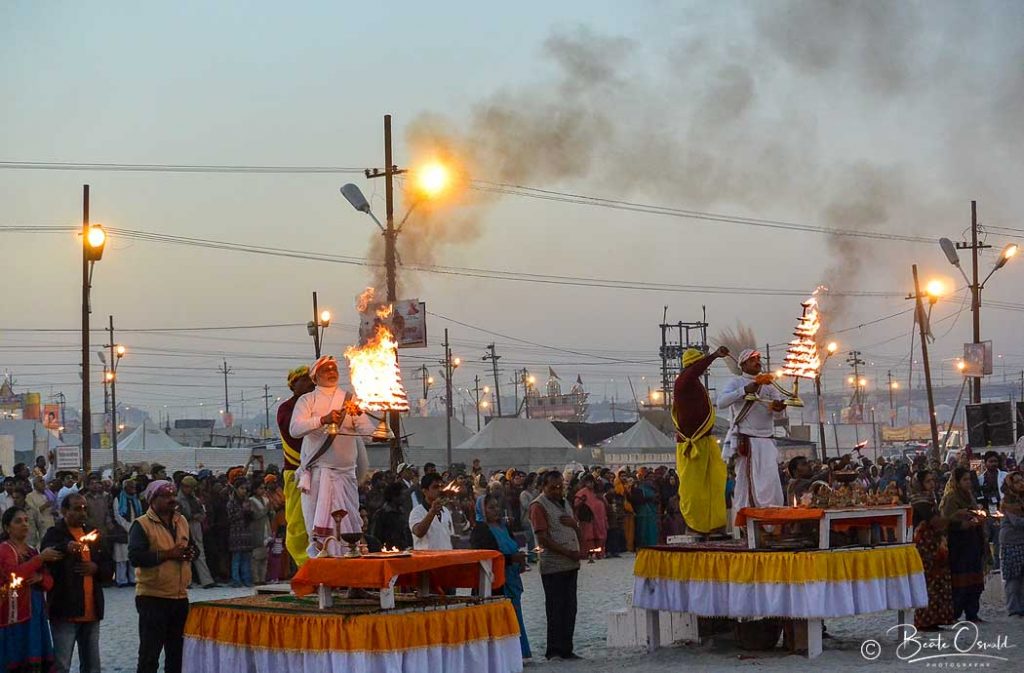
Eine von Tausenden religiösen Zeremonien, die während des Festivals durchgeführt wurden. Dieser fand zwei Nächte vor dem Mauni Amavasya statt.
English version:
One of thousands of religious ceremonies carried out during the festival. This one was two nights before the Mauni Amavasya.
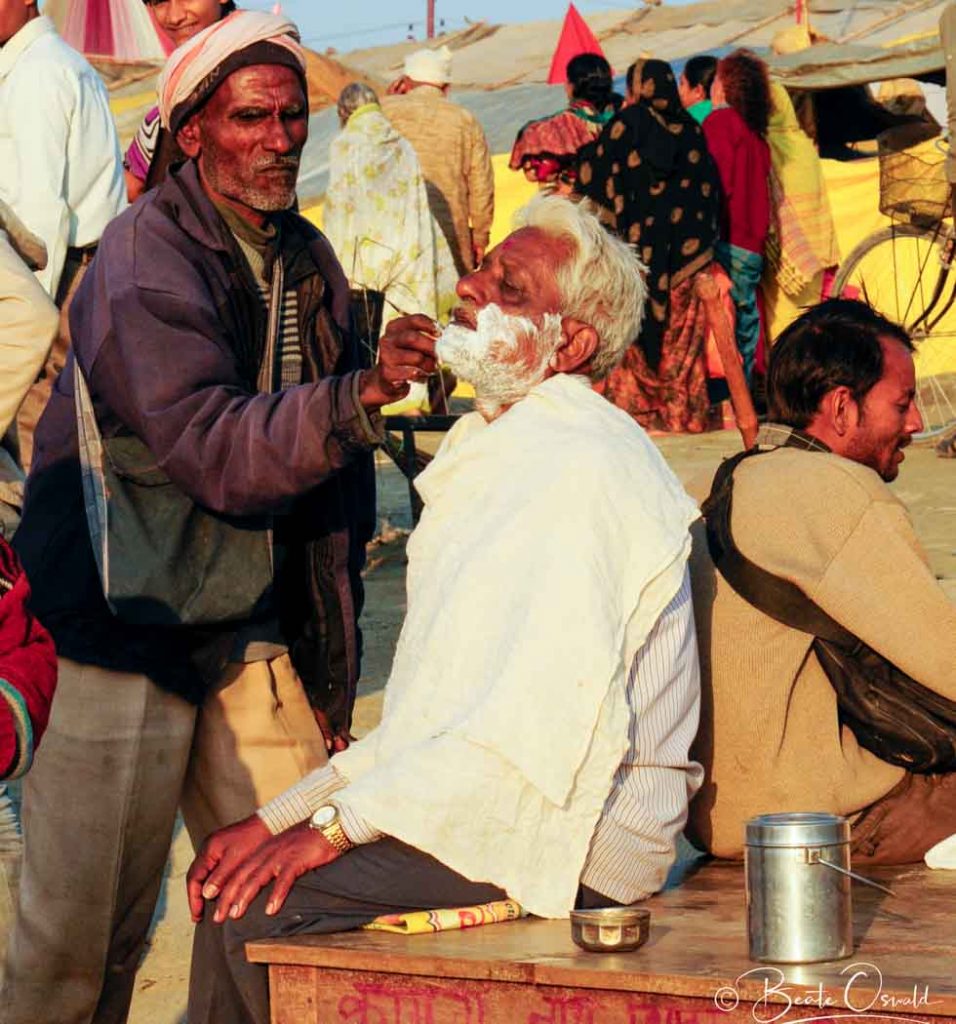
Ein Friseur übt sein Handwerk in der Zeltstadt aus.
English version:
A barber plies his trade in the tented city.
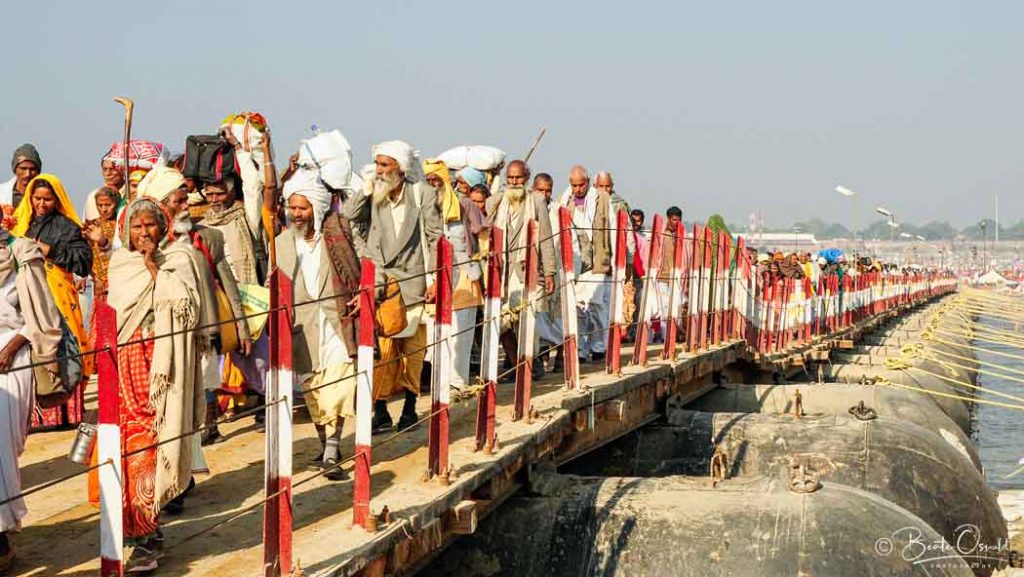
Pilgerströme sind den ganzen Tag unterwegs, jeden Tag. Das Flussufer wird immer geschäftiger, je näher wir dem Mauni Amavasya kommen. Pilger gehen zu und von den heiligen Stätten und Badebereichen.
English version:
There are people moving all day, every day. The riverbank gets busier as we get closer to the Mauni Amavasya. Pilgrims are walking to and from the holy sites and bathing areas.
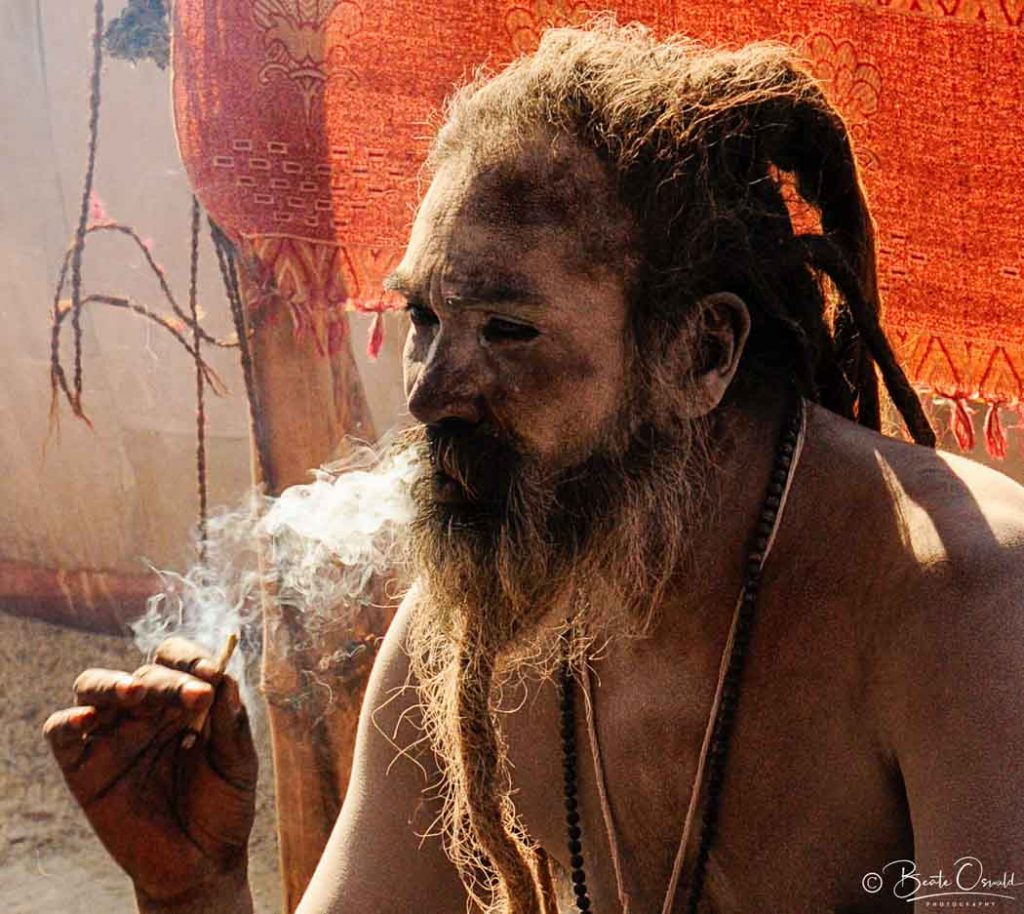
Die Sadhus haben eine wichtige Rolle auf der Kumbh Mela. Viele Pilger kommen zu ihnen, um sich mit heiliger Asche segnen zu lassen. Im Gespräch geben die Sadhus Rat und beten für die Pilger. Von den Pilgern wird erwartet, dass sie Geld oder Nahrung als Gegenleistung geben oder einfach als Akt der Frömmigkeit.
English version:
Sadhus have an important role in the Kumbh Mela. Many pilgrims come to see them to be blessed with holy ashes. During a conversation, Sadhus give advice and also pray for the pilgrims. Pilgrims are expected to give them money or food in return or simply as an act of piety.
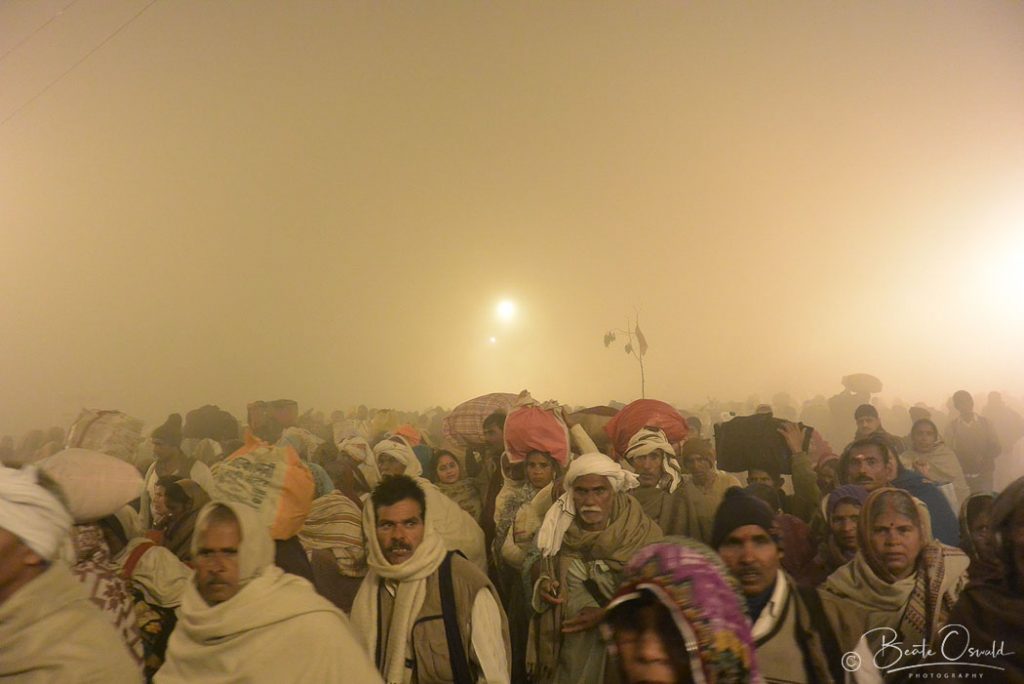
Die Menschen gehen in der Nacht vor dem Mauni Amavasya zum Fluss, um nahe genug zu sein, um am heiligsten Tag des Festivals baden zu können.
English version:
People walk to the river the night before the Mauni Amavasya, to get close enough to bathe on the holiest day of the festival.
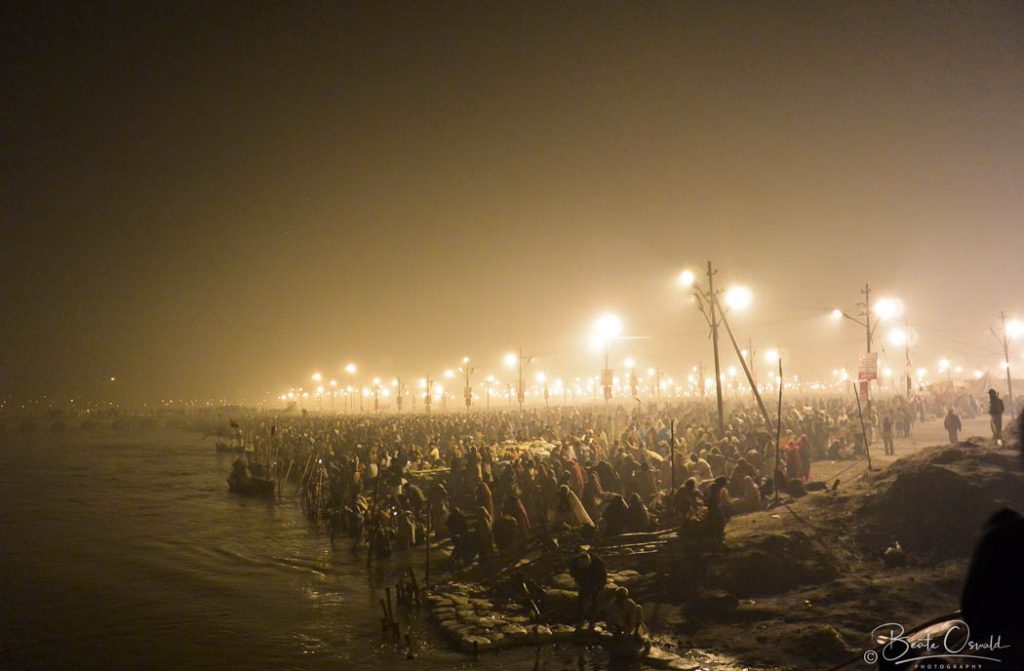
Am Abend vor Mauni Amavasya kommen immer mehr Menschen am Flussufer an.
English version:
The evening before Mauni Amavasya, more and more people arrive at the riverbank.
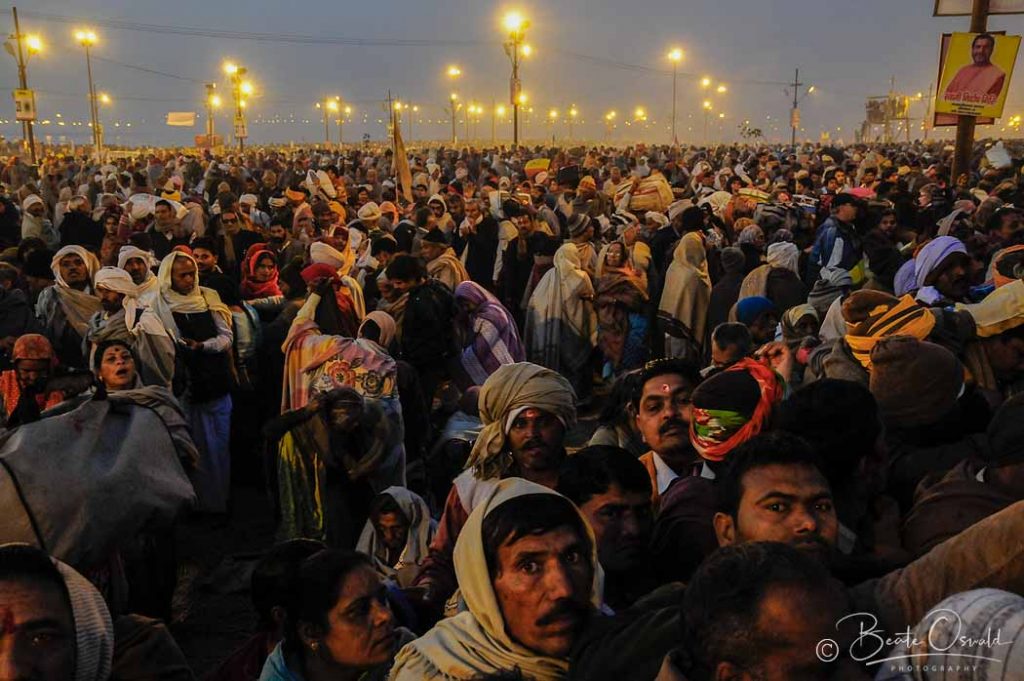
Am frühen Morgen des Mauni Amavasya: An diesem Tag gehen mehr als 20 Millionen Menschen zu den Flussufern, um im heiligen Wasser baden zu können.
English version:
Early in the morning of the Mauni Amavasya; during this day, more than 20 million people walk to the rivers to take their turn bathing in the sacred waters.
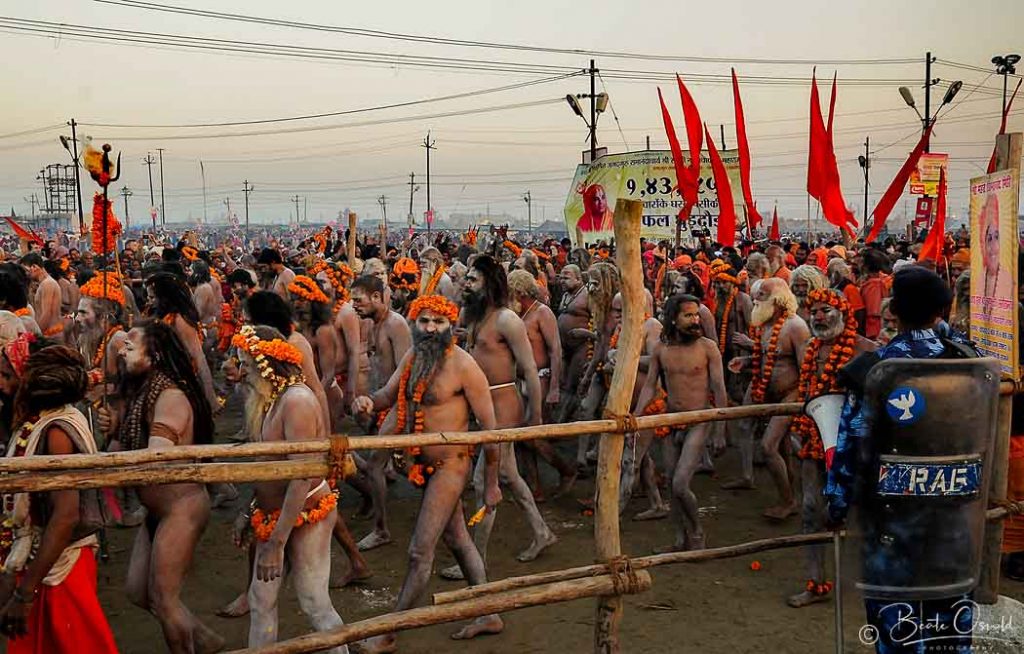
Mit Asche bedeckte Sadhus gehen zu den Flüssen, um am frühen Morgen rituell einzutauchen. Am Tag vor dem Neumond, dem Mauni Amavasya, baden Millionen von Menschen in den heiligen Flüssen.
English version:
The most important Sadhus are regarded as close to gods in their own right. Here an important holy man is driven on a flower ornated carriage to the river.
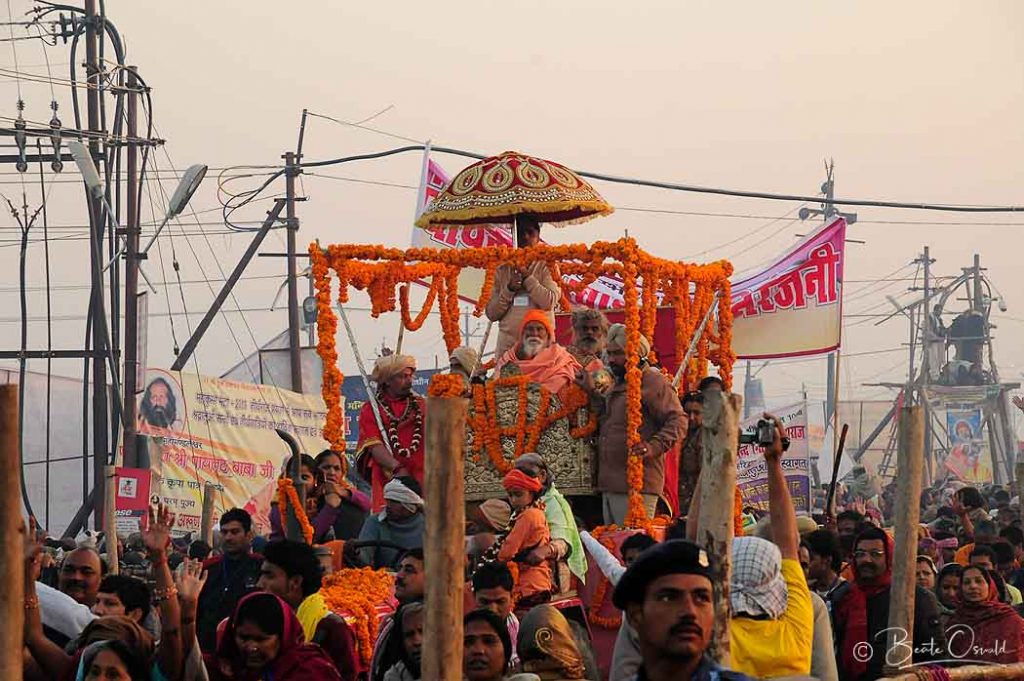
Die wichtigsten Sadhus gelten als den Göttern nahe und mit eigenen Rechten. Hier wird ein wichtiger heiliger Mann auf einem mit Blumen geschmückten Wagen zum Fluss gefahren.
English version:
The most important Sadhus are regarded as close to gods in their own right. Here an important holy man is driven on a flower ornated carriage to the river.
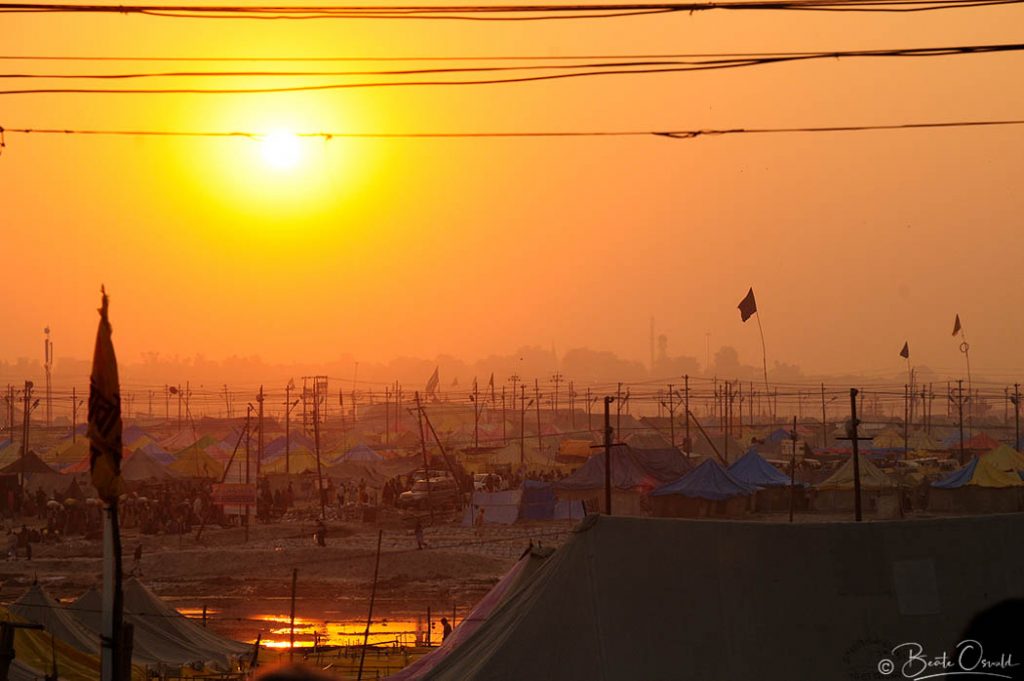
Jeden Tag bin ich ungefähr 10 km von meinem Zelt zum Festival und wieder zurückgegangen. Der Besuch der Kumbh Mela war eine einmalige Erfahrung. Eine meiner intensivsten Erinnerungen ist der nie endende Geräusche Wirrwarr an Gebeten, Segnungen, Lautsprecherdurchsagen vermisster Personen, Trillerpfeifen der Polizei, Hupen und das Murmeln von Millionen von Pilgern, die bei diesem außergewöhnlichen Ereignis zusammenkamen.
English version:
Each day I walked approximately 10 km each way from my tent to the festival and back again. Visiting the Kumbh Mela was a once-in-a-lifetime experience. One of my strongest memories was of the never-ending hubbub of prayer, blessings, loudspeaker announcements of missing people, sound of police whistles, car horns and conversation of millions of pilgrims who came together at this extraordinary event.
